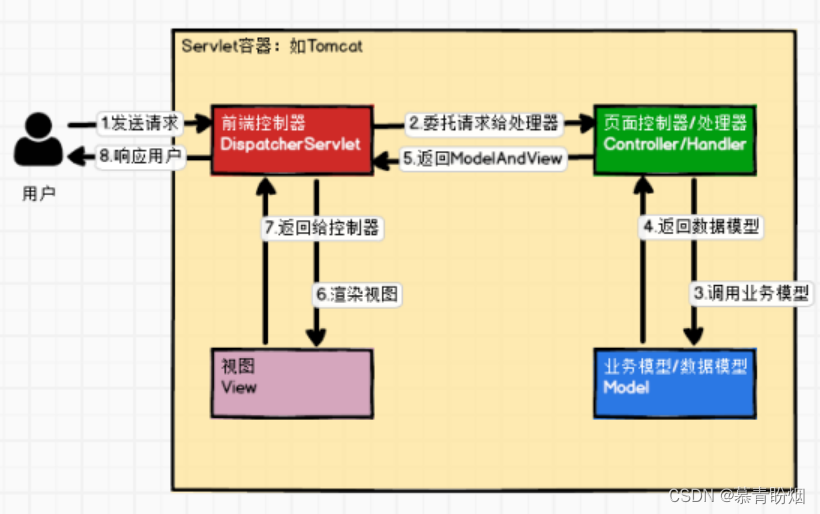本文主要是介绍第一章 初始 Spring MVC,希望对大家解决编程问题提供一定的参考价值,需要的开发者们随着小编来一起学习吧!
目录
1.2 SpringMVC处理请求原理简图
第二章 SpringMVC搭建框架
2.1 pom.xml
2.2 web.xml
2.3 springmvc.xml
2.4 HelloController
第三章 @RequestMapping详解
3.1 @RequestMapping注解位置
3.2 @RequestMapping注解属性
3.3 @RequestMapping支持Ant 风格的路径(了解)
常用通配符
第四章 @PathVariable 注解
4.1 @PathVariable注解位置
4.2 @PathVariable注解作用
4.3 @PathVariable注解属性
第五章 REST【RESTful】风格CRUD
5.1 REST的CRUD与传统风格CRUD对比
5.2 REST风格CRUD优势
5.3 实现PUT&DELETE提交方式步骤
5.4 源码解析HiddenHttpMethodFilter
第六章 SpringMVC处理请求数据
6.1 处理请求参数
6.2 处理请头
6.3 处理Cookie信息
6.4 使用原生Servlet-API
1.1 SpringMVC概述
-
SpringMVC是Spring子框架
-
SpringMVC是Spring 为【展现层|表示层|表述层|控制层】提供的基于 MVC 设计理念的优秀的 Web 框架,是目前最主流的MVC 框架。
-
SpringMVC是非侵入式:可以使用注解让普通java对象,作为请求处理器【Controller】。
-
SpringMVC是用来代替Servlet
Servlet作用
-
处理请求
-
跳转页面
-
-
1.2 SpringMVC处理请求原理简图
-
请求
-
DispatcherServlet【前端控制器】
-
将请求交给Controller|Handler
-
-
Controller|Handler【请求处理器】
-
处理请求
-
返回数据模型
-
-
ModelAndView
-
Model:数据模型
-
View:视图对象或视图名
-
-
DispatcherServlet渲染视图
-
将数据共享到域中
-
跳转页面【视图】
-
-
响应

第二章 SpringMVC搭建框架
2.1 pom.xml
-
创建工程【web工程】
-
导入jar包
<!--spring-webmvc-->
<dependency>
<groupId>org.springframework</groupId>
<artifactId>spring-webmvc</artifactId>
<version>5.3.1</version>
</dependency><!-- 导入thymeleaf与spring5的整合包 -->
<dependency>
<groupId>org.thymeleaf</groupId>
<artifactId>thymeleaf-spring5</artifactId>
<version>3.0.12.RELEASE</version>
</dependency><!--servlet-api-->
<dependency>
<groupId>javax.servlet</groupId>
<artifactId>javax.servlet-api</artifactId>
<version>4.0.1</version>
<scope>provided</scope>
</dependency>
2.2 web.xml
注册DispatcherServlet
-
url配置:/
-
init-param:contextConfigLocation,设置springmvc.xml配置文件路径【管理容器对象】
-
<load-on-startup>:设置DispatcherServlet优先级【启动服务器时,创建当前Servlet对象】
<?xml version="1.0" encoding="UTF-8"?>
<web-app xmlns="http://xmlns.jcp.org/xml/ns/javaee"
xmlns:xsi="http://www.w3.org/2001/XMLSchema-instance"
xsi:schemaLocation="http://xmlns.jcp.org/xml/ns/javaee http://xmlns.jcp.org/xml/ns/javaee/web-app_4_0.xsd"
version="4.0">
<servlet>
<servlet-name>DispatcherServlet</servlet-name>
<servlet-class>org.springframework.web.servlet.DispatcherServlet</servlet-class>
<load-on-startup>1</load-on-startup>
<init-param>
<param-name>contextConfigLocation</param-name>
<param-value>classpath:springmvc.xml</param-value>
</init-param>
</servlet>
<servlet-mapping>
<servlet-name>DispatcherServlet</servlet-name>
<url-pattern>/</url-pattern>
</servlet-mapping>
</web-app>
2.3 springmvc.xml
<?xml version="1.0" encoding="UTF-8"?>
<beans xmlns="http://www.springframework.org/schema/beans"
xmlns:xsi="http://www.w3.org/2001/XMLSchema-instance" xmlns:context="http://www.springframework.org/schema/context"
xmlns:util="http://www.springframework.org/schema/util"
xmlns:mvc="http://www.springframework.org/schema/mvc"
xsi:schemaLocation="
http://www.springframework.org/schema/beans
http://www.springframework.org/schema/beans/spring-beans.xsd
http://www.springframework.org/schema/context
http://www.springframework.org/schema/context/spring-context.xsd
http://www.springframework.org/schema/util
http://www.springframework.org/schema/util/spring-util.xsd
http://www.springframework.org/schema/mvc
http://www.springframework.org/schema/mvc/spring-mvc.xsd">
<context:component-scan base-package="com.haogu"/>
</beans>
2.4 HelloController
@Controller
public class HelloController {@ResponseBody
@GetMapping("1.do")
public String hello(){
return "hello";
}
}
第三章 @RequestMapping详解
@RequestMapping注解作用:为指定的类或方法设置相应URL
3.1 @RequestMapping注解位置
-
书写在类上面
-
作用:为当前类设置映射URL
-
注意:不能单独使用,需要与方法上的@RequestMapping配合使用
-
-
书写在方法上面
-
作用:为当前方法设置映射URL
-
注意:可以单独使用
-
3.2 @RequestMapping注解属性
-
value属性
-
类型:String[]
-
作用:设置URL信息
-
-
path属性
-
类型:String[]
-
作用:与value属性作用一致
-
-
method属性
-
类型:RequestMethod[]
-
public enum RequestMethod {
GET, HEAD, POST, PUT, PATCH, DELETE, OPTIONS, TRACE
}
-
-
作用:为当前URL【类或方法】设置请求方式【POST、DELETE、PUT、GET】
-
注意:
-
默认情况:所有请求方式均支持
-
如请求方式不支持,会报如下错误
-
405【Request method 'GET' not supported】
-
-
-
-
params
-
类型:String[]
-
作用:为当前URL设置请求参数
-
注意:如设置指定请求参数,但URL中未携带指定参数,会报如下错误
-
400【Parameter conditions "lastName" not met for actual request parameters:】
-
-
-
headers
-
类型:String[]
-
作用:为当前URL设置请求头信息
-
注意:如设置指定请求头,但URL中未携带请求头,会报如下错误
-
404:请求资源未找到
-
-
@RequestMapping(value = {"/saveEmp","/insertEmp"},
method = RequestMethod.GET,
params = "lastName=lisi",
headers = "User-Agent=Mozilla/5.0 (Windows NT 10.0; Win64; x64) AppleWebKit/537.36 (KHTML, like Gecko) Chrome/99.0.4844.84 Safari/537.36")
public String saveEmp(){
System.out.println("添加员工信息!!!!");return "hello";
}
@RequestMapping(method = RequestMethod.POST)
public @interface PostMapping {}
@RequestMapping(method = RequestMethod.GET)
public @interface GetMapping {}
@RequestMapping(method = RequestMethod.PUT)
public @interface PutMapping {}
@RequestMapping(method = RequestMethod.DELETE)
public @interface DeleteMapping {}
3.3 @RequestMapping支持Ant 风格的路径(了解)
-
常用通配符
a) ?:匹配一个字符
b) *:匹配任意字符
c) **:匹配多层路径
-
示例代码
@RequestMapping("/testAnt/**")
public String testAnt(){
System.out.println("==>testAnt!!!");
return "SUCCESS";
}
第四章 @PathVariable 注解
4.1 @PathVariable注解位置
@Target(ElementType.PARAMETER)
-
书写在参数前面
4.2 @PathVariable注解作用
-
获取URL中占位符参数
-
占位符语法:{}
-
示例代码
@GetMapping("1.do/{uid}")
public String hello(@PathVariable String uid){
System.out.println(uid);
return "hello";
}
4.3 @PathVariable注解属性
-
value属性
-
类型:String
-
作用:设置占位符中的参数名
-
-
name属性
-
类型:String
-
作用:与name属性的作用一致
-
-
required属性
-
类型:boolean
-
作用:设置当前参数是否必须入参【默认值:true】
-
true:表示当前参数必须入参,如未入参会报如下错误
-
Missing URI template variable 'empId' for method parameter of type Integer
-
-
false:表示当前参数不必须入参,如未入参,会装配null值
-
-
第五章 REST【RESTful】风格CRUD
5.1 REST的CRUD与传统风格CRUD对比
-
传统风格CRUD
-
功能 URL 请求方式 增 /insertEmp POST
-
删 /deleteEmp?empId=1001 GET
-
改 /updateEmp POST
-
查 /selectEmp?empId=1001 GET
-
-
REST风格CRUD
-
功能 URL 请求方式 增 /emp POST
-
删 /emp/1001 DELETE
-
改 /emp PUT
-
查 /emp/1001 GET
-
5.2 REST风格CRUD优势
-
提高网站排名
-
排名方式
-
竞价排名
-
技术排名
-
-
-
便于第三方平台对接
5.3 实现PUT&DELETE提交方式步骤
-
注册过滤器HiddenHttpMethodFilter
-
设置表单的提交方式为POST
-
设置参数:_method=PUT或_method=DELETE
5.4 源码解析HiddenHttpMethodFilter
public static final String DEFAULT_METHOD_PARAM = "_method";
private String methodParam = DEFAULT_METHOD_PARAM;
@Override
protected void doFilterInternal(HttpServletRequest request, HttpServletResponse response, FilterChain filterChain)
throws ServletException, IOException {HttpServletRequest requestToUse = request;
if ("POST".equals(request.getMethod()) && request.getAttribute(WebUtils.ERROR_EXCEPTION_ATTRIBUTE) == null) {
String paramValue = request.getParameter(this.methodParam);
if (StringUtils.hasLength(paramValue)) {
String method = paramValue.toUpperCase(Locale.ENGLISH);
if (ALLOWED_METHODS.contains(method)) {
requestToUse = new HttpMethodRequestWrapper(request, method);
}
}
}filterChain.doFilter(requestToUse, response);
}
/**
* Simple {@link HttpServletRequest} wrapper that returns the supplied method for
* {@link HttpServletRequest#getMethod()}.
*/
private static class HttpMethodRequestWrapper extends HttpServletRequestWrapper {private final String method;
public HttpMethodRequestWrapper(HttpServletRequest request, String method) {
super(request);
this.method = method;
}@Override
public String getMethod() {
return this.method;
}
}
第六章 SpringMVC处理请求数据
使用Servlet处理请求数据
请求参数
String param = request.getParameter();
请求头
request.getHeader();
Cookie
request.getCookies();
6.1 处理请求参数
-
默认情况:可以将请求参数名,与入参参数名一致的参数,自动入参【自动类型转换】
-
SpringMVC支持POJO入参
-
要求:请求参数名与POJO的属性名保持一致
-
示例代码
-
<form action="/saveEmp" method="POST">
id:<input type="text" name="id"><br>
LastName:<input type="text" name="lastName"><br>
Email:<input type="text" name="email"><br>
Salary:<input type="text" name="salary"><br>
<input type="submit" value="添加员工信息">
</form>
@RequestParam注解
-
作用:如请求参数与入参参数名不一致时,可以使用@RequestParam注解设置入参参数名
-
属性
-
value
-
类型:String
-
作用:设置需要入参的参数名
-
-
name
-
类型:String
-
作用:与value属性作用一致
-
-
required
-
类型:Boolean
-
作用:设置当前参数,是否必须入参
-
true【默认值】:表示当前参数必须入参,如未入参会报如下错误
-
400【Required String parameter 'sName' is not present】
-
-
false:表示当前参数不必须入参,如未入参,装配null值
-
-
-
defaultValue
-
类型:String
-
作用:当装配数值为null时,指定当前defaultValue默认值
-
-
-
示例代码
/**
* 获取请求参数
* @return
*/
@RequestMapping("/requestParam1")
public String requestParam1(@RequestParam(value = "sName",required = false,
defaultValue = "zhangsan")
String stuName,
Integer stuAge){
System.out.println("stuName = " + stuName);
System.out.println("stuAge = " + stuAge);
return SUCCESS;
}
6.2 处理请头
-
语法:@RequestHeader注解
-
属性
-
value
-
类型:String
-
作用:设置需要获取请求头名称
-
-
name
-
类型:String
-
作用:与value属性作用一致
-
-
required
-
类型:boolean
-
作用:【默认值true】
-
true:设置当前请求头是否为必须入参,如未入参会报如下错误
-
400【Required String parameter 'sName' is not present】
-
-
false:表示当前参数不必须入参,如未入参,装配null值
-
-
-
defaultValue
-
类型:String
-
作用:当装配数值为null时,指定当前defaultValue默认值
-
-
-
示例代码
<a th:href="@{/testGetHeader}">测试获取请求头</a>
/**
* 获取请求头
* @return
*/
@RequestMapping(value = "/testGetHeader")
public String testGetHeader(@RequestHeader("Accept-Language")String al,
@RequestHeader("Referer") String ref){
System.out.println("al = " + al);
System.out.println("ref = " + ref);
return SUCCESS;
}
6.3 处理Cookie信息
-
语法:@CookieValue获取Cookie数值
-
属性
-
value
-
类型:String
-
作用:设置需要获取Cookie名称
-
-
name
-
类型:String
-
作用:与value属性作用一致
-
-
required
-
类型:boolean
-
作用:【默认值true】
-
true:设置当前Cookie是否为必须入参,如未入参会报如下错误
-
400【Required String parameter 'sName' is not present】
-
-
false:表示当前Cookie不必须入参,如未入参,装配null值
-
-
-
defaultValue
-
类型:String
-
作用:当装配数值为null时,指定当前defaultValue默认值
-
-
-
示例代码
/**
* 设置Cookie
* @return
*/
@RequestMapping("/setCookie")
public String setCookie(HttpSession session){
// Cookie cookie = new Cookie();
System.out.println("session.getId() = " + session.getId());
return SUCCESS;
}/**
* 获取Cookie
* @return
*/
@RequestMapping("/getCookie")
public String getCookie(@CookieValue("JSESSIONID")String cookieValue){
System.out.println("cookieValue = " + cookieValue);
return SUCCESS;
}
6.4 使用原生Servlet-API
-
将原生Servlet相关对象,入参即可
@RequestMapping("/useRequestObject")
public String useRequestObject(HttpServletRequest request){}
这篇关于第一章 初始 Spring MVC的文章就介绍到这儿,希望我们推荐的文章对编程师们有所帮助!





